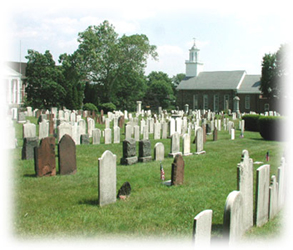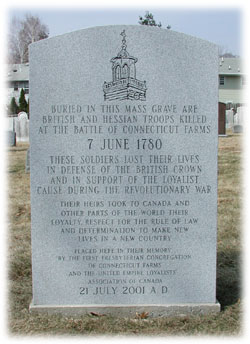
The history of the Connecticut Farms Cemetery is closely associated with the history of Connecticut Farms Presbyterian Church and the Township of Union.
The cemetery was established by church members shortly after the original structure of the church was built in 1730. Land was marked off land north and south of the meetinghouse as consecrated ground for the purpose of burying the dead. The first person to be buried in the cemetery was Daniel Burnet in 1732.

It remains classified as a rural cemetery having the appearance of older cemeteries in New England. In the late 1800s, church trustees purchased a portion of a wrought iron fence scrapped by the Newark Insane Asylum when it expanded its facility in Newark. This portion was placed along the Stuyvesant Avenue side of the cemetery and remains there to this day. The remaining sides of the cemetery remained unfenced for many years. The north side borders additional church land that is used as the site of its third parsonage built in 1895. In the late 1940's, the church expanded its facility to the south of the present structure, necessitating the disinterment and re-interment of the graves located south of the church to the north side. In 1968, the remaining sides of the cemetery were enclosed with a six-foot chain-linked fence. Access is limited to Holy days or to special requests. Visitors are required to register in the church office.
The cemetery still retains its 18th century charm with some interesting oddities. To the discerning eye, the original path can still be seen that served as the original north border of the cemetery in 1730. Though long since outgrowing this original boundary, the church has not allowed graves to be placed on this narrow strip of grass that runs east to west, though the path no longer has a functional purpose. The southwest corner marks an area used in the eighteenth and early nineteenth century for the discreet burial of illegitimate children who died in childbirth.
 The cemetery contains one crypt, that of the Wilson family. Most stones are upright and many remain in good condition. There is a sizable collection of brownstones with carvings ranging from winged death to flowers and vines. A significant number are inscribed with prose and scripture and some bear the names of their original carvers. The early marble gravestones have suffered the ravages of acid rain. Some are difficult to read. Others can be read under only appropriate lighting conditions, and still others have very clear inscriptions. Granite stones date primarily from the late nineteenth century to the present day.
The cemetery contains one crypt, that of the Wilson family. Most stones are upright and many remain in good condition. There is a sizable collection of brownstones with carvings ranging from winged death to flowers and vines. A significant number are inscribed with prose and scripture and some bear the names of their original carvers. The early marble gravestones have suffered the ravages of acid rain. Some are difficult to read. Others can be read under only appropriate lighting conditions, and still others have very clear inscriptions. Granite stones date primarily from the late nineteenth century to the present day.
In 2000, the church undertook (at considerable expense) restoration work throughout the cemetery. Broken stones were mended. Gravestones that had sunken almost out of sight were lifted and restored to their original height. A pile of gravestones stacked along the back fence (for purposes unknown) were restored to their original sites. The cemetery is mowed every two weeks from spring to autumn. It remains one of the best-kept church cemeteries in north-central New Jersey.
 The cemetery is also the location of a mass grave of Hessian and British soldiers who lost their lives in the Battle of Connecticut Farms on June 7 in 1780. Unmarked for most of their existence, these graves were re-interned in the north side of the cemetery when the church underwent expansion in the late 1940s. In 2001, Connecticut Farms Presbyterian Church and the United Empire Loyalists' Association of Canada jointly placed a commemorative marker on the site when the church celebrated its life and ministry during its Heritage Renewal Weekend.
The cemetery is also the location of a mass grave of Hessian and British soldiers who lost their lives in the Battle of Connecticut Farms on June 7 in 1780. Unmarked for most of their existence, these graves were re-interned in the north side of the cemetery when the church underwent expansion in the late 1940s. In 2001, Connecticut Farms Presbyterian Church and the United Empire Loyalists' Association of Canada jointly placed a commemorative marker on the site when the church celebrated its life and ministry during its Heritage Renewal Weekend.
Many of the people buried in the cemetery were members of the older families in Connecticut Farms (now Union). The cemetery is also the final resting place of the first mayor of Elizabeth, a number of revolutionary solders, farmers and their kin and recent members of the church.
Additionally there is an area (established in the 18th century) as the Ministers' Plat, which has served as land set aside for clergy and their families. The Reverend Samuel Smith who served 1800-1801, and died suddenly in 1801, is buried there along with the first wives of the Rev. Stephen Thompson (Caroline Mary Thompson), The Rev. Robert Street (Henrietta Street), and the daughter of the Rev. Benjamin Hait (Mary Hait). Several other clergy, The Rev. Charles Converse (1847-1903) and the Rev Frederick Druckenmiller (1896-1969) are buried in other areas near the church. The location of the grave of the Rev. Druckenmiller fulfilled his request to be buried next to his office window.
There have been fanciful stories that the cemetery has its own ghost - that of a British solder who lost his life in the Revolutionary War battle of Connecticut Farms in 1780. He has been reputed to have seen wandering and sitting, along side of his grave, as though bemoaning his demise. For theological reasons the church rejects any attempt to legitimate this story and refuses entrance of persons into the cemetery for this purpose.
The church currently uses the cemetery for burial of church members and its annual Easter Sunrise service, Easter egg hunt and an annual Halloween walk for the children of the church.
Connecticut Farms Presbyterian Church is proud of its cemetery and takes as a sacred task its maintenance and preservation.